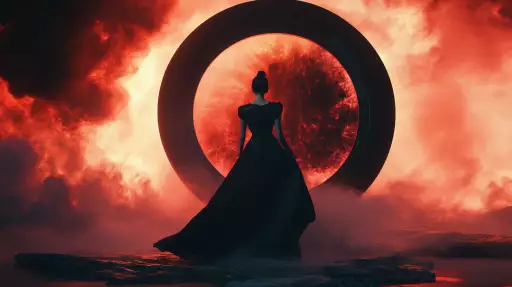Explore the Best AI Image Gallery

Pixels on Your Skin: How AI-Generated Images are Transforming Art
The art world is buzzing with a new kind of creativity: one born from algorithms and fueled by data. AI-generated images, once the realm of science fiction, are now a tangible reality, blurring the lines between human and machine artistry and sparking heated debate about the future of creative expression.
These digital masterpieces are crafted not by hand but by complex neural networks trained on vast datasets of existing artwork. From photorealistic landscapes to abstract compositions, AI algorithms can generate images that rival, and sometimes even surpass, traditional artistic techniques.
Impact on the Creative Industry
The emergence of AI-generated art has sent ripples through the creative industry, both exciting and unsettling. On one hand, it offers artists new tools for inspiration and collaboration, allowing them to explore unconventional ideas and push the boundaries of their imagination.
- New Avenues for Expression: Artists can leverage AI to generate unique visuals for their projects, overcoming creative blocks or experimenting with novel styles and aesthetics.
- Democratization of Art Creation: AI tools make art creation accessible to a wider audience, regardless of technical skill. Anyone with an idea can now explore their artistic potential without needing years of training.
- Efficiency and Automation: Artists can use AI to automate repetitive tasks, such as generating backgrounds or creating variations of a design, freeing up time for more conceptual work.
However, concerns also arise about the potential displacement of human artists. Some argue that AI-generated art lacks the emotional depth and originality found in works created by humans.
Potential Uses Beyond Art
The applications of AI-generated images extend far beyond the realm of fine art. They are already finding use in various industries:
- Advertising and Marketing: Creating personalized ads, generating product visualizations, and developing engaging marketing campaigns.
- Gaming and Entertainment: Designing characters, environments, and assets for video games, creating realistic visual effects, and enhancing immersive experiences.
- Education and Research: Generating visualizations for scientific data, creating interactive learning materials, and simulating complex scenarios.
Ethical Considerations
The rise of AI-generated art raises important ethical questions that need careful consideration:
- Authorship and Copyright: Who owns the copyright to AI-generated art? Is it the creator of the algorithm, the user who provides input, or the AI itself?
- Bias and Representation: AI algorithms are trained on existing datasets, which can perpetuate societal biases and lead to underrepresentation of certain groups.
- Misinformation and Deepfakes: The ability to create realistic fake images raises concerns about the spread of misinformation and the erosion of trust in visual media.
These ethical challenges require ongoing dialogue and collaboration between artists, technologists, policymakers, and the general public to ensure responsible development and deployment of AI-generated art.
Future Trends
The field of AI-generated art is rapidly evolving. Here are some trends shaping its future:
- Increased Accessibility: More user-friendly AI tools will empower individuals with limited technical skills to create their own artwork.
- Personalized Art Experiences: AI algorithms will learn individual preferences and generate customized artworks tailored to specific tastes.
- Integration with Virtual and Augmented Reality: AI-generated images will enhance immersive experiences in virtual worlds and augmented reality applications.
- Ethical Frameworks and Regulations: As AI technology advances, clearer guidelines and regulations will emerge to address ethical concerns and promote responsible use.
AI-generated art is a transformative force, reshaping the creative landscape and pushing the boundaries of human imagination. While it presents both opportunities and challenges, embracing its potential while navigating its ethical complexities is crucial for shaping a future where art and technology coexist harmoniously.





](https://images.ai-img.art/thumbnails/150/157712d76865d557120f9baf988de3d0525225295a2789c89bf2c4a5a96a03d1.webp)





![**Representation: A dog acting as a private tutor to a child. The dog holds a ruler in its paw and stands at the blackboard to explain a dog diagram to the child. Graphic style: Line drawing, cartoon style, influenced by Franco-Belgian comics, thick black lines, simplified design, vector, black and white only, in the style of Keith Haring or the French comic strip "Alinéa". [IMPORTANT]: A single continuous line extending from one side of the image to the other, minimalist, strong outlines, line drawing, without lifting the hand, ultra-simplified, no shading, entirely white image, drawing created in the center of a sheet of paper. --ar 16:5** - Variations (Strong) by <@627984126871470085> (fast)](https://images.ai-img.art/thumbnails/150/f4e034998ccd869d8a061fd12017514fcd92210eb33d4222dc9b54716223f4dd.webp)






](https://images.ai-img.art/thumbnails/150/9d51c5e673b4f2068b7b01abc35425a06f173b76303adf9ad29ca14302c25b18.webp)


![**Representation: A dog acting as a private tutor to a child. The dog holds a ruler in its paw and stands at the blackboard to explain a dog diagram to the child. Graphic style: Line drawing, cartoon style, influenced by Franco-Belgian comics, thick black lines, simplified design, vector, black and white only, in the style of Keith Haring or the French comic strip "Alinéa". [IMPORTANT]: A single continuous line extending from one side of the image to the other, minimalist, strong outlines, line drawing, without lifting the hand, ultra-simplified, no shading, entirely white image, drawing created in the center of a sheet of paper. --ar 16:5** - <@627984126871470085> (fast)](https://images.ai-img.art/thumbnails/150/7a854648a81e51241dcca8d24dd6e3bfcf07ad1df51baf401c9b729f4cf411fa.webp)





![**Representation: A teenager smiling while thinking about a friendly dog, a comic-style thought bubble with a friendly dog inside. Graphic style: Line drawing, cartoon style, influenced by Franco-Belgian comics, thick black lines, simplified design, vector, black and white only, in the style of Keith Haring or the French comic strip "Alinéa". [IMPORTANT]: A single continuous line extending from one side of the image to the other, minimalist, strong outlines, line drawing, without lifting the hand, ultra-simplified, no shading, entirely white image, drawing created in the center of a sheet of paper. --ar 16:5** - <@627984126871470085> (fast)](https://images.ai-img.art/thumbnails/150/6fc850f638e3dee0c4b121acecad2c8419e02bdeac7f871d625f1003c1c3abe1.webp)






](https://images.ai-img.art/thumbnails/150/51c93500396faff4e7fa8b42bc68033067b16b2230e3496e95c482a581ff0fe9.webp)









